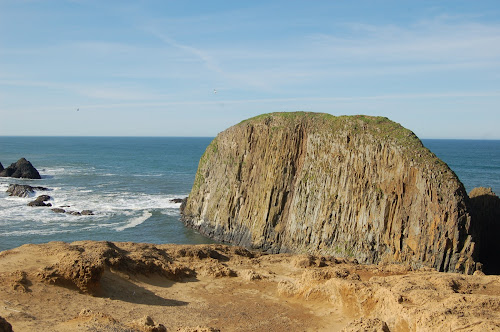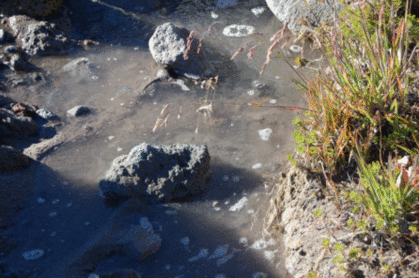What makes a landscape beautiful, or a rock beautiful or a fossil beautiful, is more than just its superficial attractiveness. These things also have geological information. In documenting them, the geologist's task is like that of the portrait photographer: to show the beauty in the true.Why tough? I got my first SLR camera in the early 1980's, after I'd already started on my geology degree. So, basically, I've been taking photos from a geological perspective from the outset of really trying to do serious photography (as opposed to random snapshots of friends). Thus it's difficult to contrast what's different in my perspective; it's the only one I know.
What I can say is this: I definitely think about the esthetic aspect when I'm framing a shot. I'm not really sure exactly what it is I think about, but I often try several different frames and zooms to get a shot that I like. The advent of DSLR's has made that much easier: with film, each shot was a bit less than a dollar taking into account film and developing costs, so a roll of 36 slides was not a cheap proposition. These days, I can fire merrily away, then pick the one or few shots I like. But I definitely want the photos to look appealing.
I tend to focus mostly on outdoor photos, at the scale of a cobble or boulder, to outcrop, to landscape scale. My photos of hand samples tend to be uninteresting, to me, at least.
But it's the comment "These things also have geological information," that resonates with me. There are two broad "topics" that I tend to focus on: things I know and understand, and want to share, and things I don't know or understand, and want to look at more carefully, or perhaps ask others what they think. Time is a huge limit on field trips, but not such a limit in looking carefully at photographs. As an example of the former, here's a recent one from "Islands of Seals:"
Now the fun thing about that one was that it was in that post I came up with a plausible explanation for a photo I'd taken moments earlier of a feature I thought, at the time, I understood, Elephant Rock:
I, like Silver Fox, am definitely thinking about what features are visible in the viewfinder before I press the shutter button. And one nice thing about digital photo technology is that it's easy to mark up and highlight the features I was looking at when I shot the image, as In the Neighborhood of the Splort:
And of course "The Splort" itself is likely my favorite photo I've taken on my new camera. I certainly did not understand WTF I was looking at with this one at the time, mostly because I was focused mainly on what had gone where, rather than looking at and thinking carefully about the faults that accommodated those motions. What I "saw" was a plug intruding down into the surrounding rock, and that just didn't make sense. So, get a picture of it.
A couple of other nice options with digital photography are the options to easily create panoramas, such the not-quite normal normal faults...
My feeling about gifs is that they offer an ability to photographically illustrate another dimension beyond the two of traditional photography. Rotating the view can offer a visceral sense of the depth in a view, or as here, the third dimension illustrated is change through time.
So in the end, I think what influences my perspective as a photographer of geology is an imperative to communicate the nature of the planet we live on. The esthetic, emotional aspects are important to me, too, but I guess even if a shot is gorgeous, if it's not telling a story, or part of a story, it's not one I'll be likely to take.






















